Highlights:
- The mainnet launch is set for December 3 after three testnet rollouts in October.
- Blob capacity will double through two-phased BPO forks post-upgrade.
- PeerDAS will improve node efficiency and reduce validator hardware requirements.
Ethereum developers have set the date of the Ethereum Fusaka upgrade mainnet release to December 3, 2025. This is after a gradual testnet rollout that will start in early October. Holesky testnet will be activated on October 1, Sepolia on October 14, and Hoodi on October 28, according to Christine Kim on X.
The testnets will each replicate the complete upgrade, with one having a key blob expansion feature. Two automatic Blob Parameter Only (BPO) forks will be developed by developers following the launch of the mainnet. These forks seek to increase the capacity of Ethereum to store more blob data without necessarily bringing about full upgrades in the network.
Important decisions were made on today's Ethereum developer call, ACDC #165. Developers confirmed the public testnet schedule and BPO hard fork schedule for Fusaka.
Let's get into it. pic.twitter.com/mNrYMYyDj2
— Christine D. Kim (@christine_dkim) September 18, 2025
Major Enhancements with Ethereum Fusaka Upgrade
The Ethereum Fusaka upgrade presents some backend features that aim at enhancing scalability and data optimization. Peer Data Availability Sampling (PeerDAS) is one of the major elements. This allows validators to validate blobs by sample rather than downloading complete data. The feature minimizes bandwidth requirements and enables higher rollup scalability.
The increase of blob limits will be done in stages. Limitations Current limits remain at 6/9 blobs when going to mainnet. On December 17, the cap is upped to 10/15 blobs. Another BPO fork switches on on January 7, making it 14/21 blobs. This growth facilitates increased transactions and reduces roll-up costs.
The upgrade also suggests raising the block gas limit. The developers will increase it to 150 million units instead of 30 million. EIP-7935 defines this increase, which will facilitate an increase in transaction throughput and readiness to scale up.
Besides this, EIP-7918 proposes a limited amount of base fees on blobs. This transformation guarantees predictable transaction costs, particularly for those applications that consume a lot of data. Verkle Trees and shrinking proof sizes are also introduced in the Fusaka upgrade, and they greatly enhance storage efficiency.
Technical Impact and Developer Implications
The Ethereum Fusaka upgrade is not user-oriented; it is a system-level upgrade. Approximately, it contains 11 Ethereum Improvement Proposals. Such modifications enhance the efficiency of the validator work, performance of nodes, and efficiency of smart contracts. Moreover, the update increases the size of the smart contract code from 24KB to 48KB, allowing for more complicated apps.
This upgrade will introduce new opcodes, which will make the computation faster and cost-efficient. Enterprises and developers will enjoy reduced gas costs and better EVM. The upgrade is also compatible with new cryptographic standards popular with both mobile and enterprise environments.
The upgrades of Testnet will make it possible to test and debug on three networks critically. The node operators have to update their respective clients with any given activation to prevent disruptions. Holesky has a deadline of September 25 (mainnet readiness) and a deadline of November 3.
😧 JUST IN: Ethereum Foundation announces shutdown of the Holesky testnet two weeks after the Fusaka upgrade.
Telegram | Twitter #Crypto #Web3 #DeFi #Finance #CryptoNews
— GSMART_MONEY (@GSMART_money) September 2, 2025
In order to win the upgrade, the Ethereum Foundation has organized a four-week contest of auditing. The program provides the researcher with up to 2 million dollars in instances where they identify vulnerabilities prior to the launch of the primary network. This competition is to provide Fusaka with security and easy implementation.
Phased feature activation will be through the use of BPO forks beyond the mainnet of Ethereum. Changing forks is based on interchangeable epochs to implement changes without significant network forks. This design is flexible, which makes transitions seamless and disruptive.
Broader Implications for the Ethereum Ecosystem
The Ethereum Fusaka upgrade aligns with the long-term objective of increasing the base layer capacity. Whereas Layer 2 solutions keep on being enhanced, Fusaka directly enhances Layer 1 efficiency. In the case of peerDAS, specifically, the hardware requirements will be decreased, which will make Ethereum more accessible to small validators.
Fusaka also incorporates criticism of Layer 2 fragmentation. Ethereum ensures that a strong core protocol works to mitigate the use of fragmented rollup environments. The upgrade goes hand in hand with projects such as EIP-9698, which calls to increase the gas by 100x within two years.
According to the developers, these infrastructure changes are the basis on which future upgrades will be based. The next hard fork, Glamsterdam, will take place in 2026. Probably, that upgrade will be the EVM Object Format and faster block times. Ethereum’s native token is trading around $4,521, with a decline of 1.40% over the past 24 hours. In addition, its market cap and trading volume have dropped to $545 billion and $31 billion, respectively.

Best Crypto Exchange
- Over 90 top cryptos to trade
- Regulated by top-tier entities
- User-friendly trading app
- 30+ million users
eToro is a multi-asset investment platform. The value of your investments may go up or down. Your capital is at risk. Don’t invest unless you’re prepared to lose all the money you invest. This is a high-risk investment, and you should not expect to be protected if something goes wrong.






